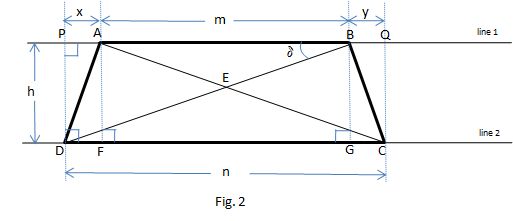Consider Figure 1
![I have created this figure using MS Excel]
( )
)
In a trapezoid ABCD that satisfies the conditions of the problem (where #BD=AC=30#, #DP=18#, and AB is parallel to CD) we notice, applying the Alternate Interior Angles Theorem, that #alpha=delta# and #beta=gamma#.
If we draw two lines perpendicular to segment AB, forming segments AF and BG, we can see that #triangle_(AFC)-=triangle_(BDG)# (because both triangles are right ones and we know that the hypotenuse of one is equal to the hypotenuse of the other and that a leg of one triangle is equal to a leg of the other triangle) then #alpha=beta# => #gamma=delta#.
Since #gamma=delta# we can see that #triangle_(ABD)-=triangle_(ABC)# and #AD=BC#, therefore the trapezoid is isosceles.
We also can see that #triangle_(ADP)-=triangle_(BCQ)# => #AP=BQ# (or #x=y# in figure 2).
Consider Figure 2
![I have created this figure using MS Excel]
( )
)
We can see that the trapezoid in figure 2 has a different shape than the one in figure 1, but both satisfy the conditions of the problem. I presented this two figures to show that the information of the problem doesn't allow to determine the sizes of the base 1 (#m#) and of the base 2 (#n#) of the trapezoid, but we'll see that there's no need of more information to calculate the trapezoid's area.
In #triangle_(BDP)#
#DB^2=DP^2+BP^2# => #30^2=18^2+(x+m)^2# => #(x+m)^2=900-324=576# => #x+m=24#
Since #n=m+x+y# and #x=y# => #n=m+2*x# and #m+n=m+m+2*x=2*(x+m)=2*24# => #m+n=48#
#S_(trapezoid)=(base_1+base_2)/2*height=(m+n)/2*18=(48*18)/2=432#
Note: we could try to determinate m and n conjugating these two equations:
In #triangle_(ADP) -> AD^2=AP^2+h^2# => #AD^2=(24-m)^2+18^2#
In #triangle_(ABD) -> AD^2=AB^2+BD^2-2*AB*BD*cos delta# => #AD^2=m^2+30^2-2*m*30*(4/5)#
(#cos delta =4/5# because #sin delta = 18/30=3/5#)
But resolving this system of two equations, we would only discover that m and the side AD are indeterminate.
 )
)  )
) 
